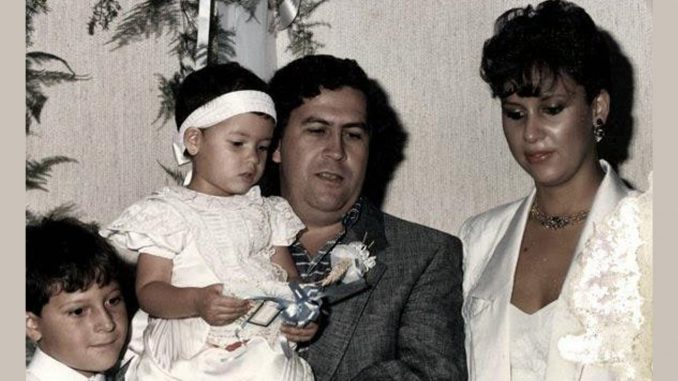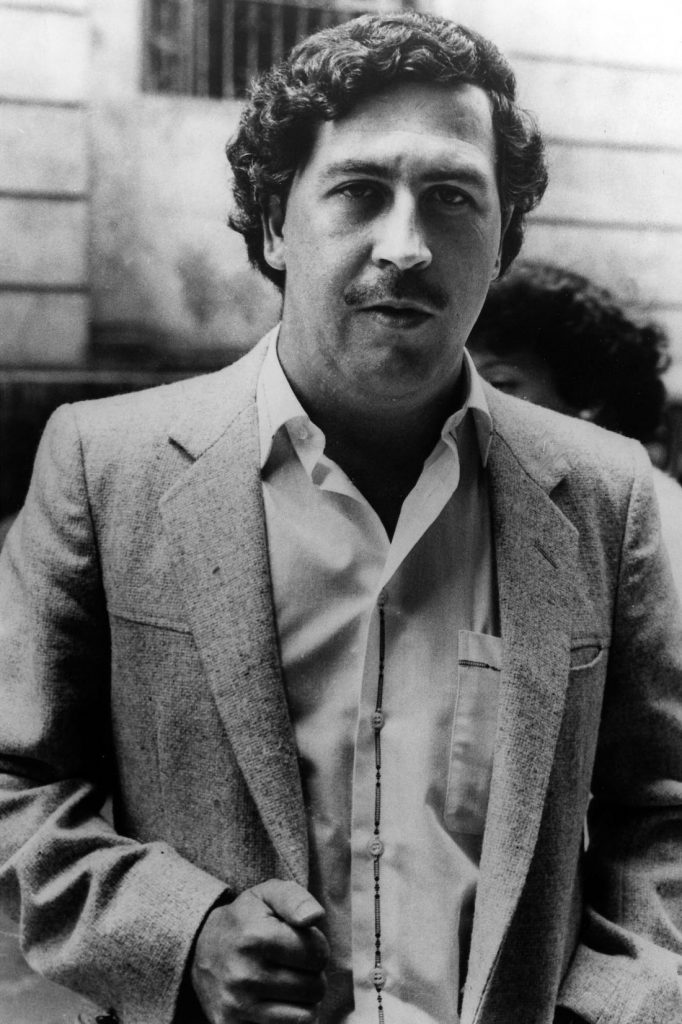
Who is Manuela Escobar?
Manuela Escobar is the only daughter of the deceased Columbian drug kingpin, Pablo Escobar; she has lived her life away from the media buzz, and not much is known about her in the media. For a time, she was helping her mother in the real estate industry, but there is no further information about her career.
Manuela Escobar Biography- Age, Childhood
Manuela was born on the 25th May 1984, in Medellin, Columbia, the daughter of Pablo Escobar and his wife, Maria Victoria Henao. She has an older brother, born Juan Pablo Escobar Henao but who now goes by the name Sebastian Marroquin . Manuela’s growing up was tough, as it was marked by constant fear of the authorities.
During her childhood, her father was at the peak of power, so the police were constantly trying to find and arrest him and the family. As a result, the family moved throughout the city, running from the police. Pablo was killed when Manuela was nine years old, and this hit her hard. She was raised in all the riches that he could provide, spoiling her in every way possible. However, all changed when he was shot and killed, and young Manuela was forced to flee the country with her mother and brother. They first migrated to Brazil, and from there to Ecuador, then Peru, and later South Africa, before they finally settled in Argentina. She changed her name to Manuela Maroquin, as the whole family changed their names to cut all association with Pablo, and hide from the authorities.
Adult Life
Not much is known about Manuela since Argentina, only that she helped her mother in her real estate business, and that she has started her own company, a pet supply store, Manee Mascotas. Her store has an Instagram page, through which she advertise and promote her business. According to some sources, Manuela is still in Argentina, living with her boyfriend, but no more information has been made available about her.
Manuela Escobar’s Father, Pablo Escobar
The richest drug dealer ever to walk the earth is dead, but his legacy lives on.

Born Pablo Emilio Escobar Gaviria on the 1st December 1949, in Rionegro, Colombia, the son of farmer Abel de Jesus Dari Escobar Echeverri, and his wife Hilda de Los Dolores Gaviria Berrio, an elementary school teacher. He had six siblings – he was the third born. He spent his childhood in Medellin, and it was in his teenage years that he turned to crime. Some sources claim that he would sell stolen gravestones, and then sand, to local smugglers. Another claim is that he was selling counterfeit high school diplomas, created at the Universidad Autonoma Latinoamericana of Medellin, which he attended, but never graduated from. As time passed he would meet other petty criminals, including Oscar Benel Aguirre, and the ystarted stealing cars and selling them, while also selling contraband cigarettes, and other illegal products.
He started being involved in a number of other illegal activities, including kidnapping, holding a Medellin executive for ransom. Eventually, he started working for Alvaro Prieto, a smuggler of contraband goods, whose area of operation was around Medellin. Pablo had a dream of becoming a millionaire at 22, and these actions helped him reach the goal – when he was 26 years old, Pablo deposited COL $100 million.
Entering the Drug Business
Starting in 1975, Pablo started convoluting his drug-dealing operation; he would fly planes out of Columbia and Panama to the US, and soon formed a fleet of 15 planes and six helicopters to increase the scale of the business. However, already in 1976, he faced his first problems, when the police caught him bringing in 18 pounds (39kg) of white paste from Ecuador.
Posted by Pablo Escobar on Tuesday, January 5, 2016
Caught with several of his men, Pablo first tried to bribe the judges, but he wasn’t successful, and after a few months and still no trial, he managed to organize the murder of the two officers who caught him smuggling goods. This became his pattern from then on – it was either bribery or murder.
Becoming the Drug King
In his first dealings, Pablo would earn as much as $500,000 per trip, but his business was expanding, and he would start bringing in the cocaine paste from other countries, including Peru. The need for cocaine was increasing at a fast pace in the US, and Pablo was always searching for new options and possibilities, and even developed shipments from the Bahamas, preferably from the island Norman’s Cay, which became the central smuggling route for the cartel.
Thanks to his success and profit, he soon bought the land in Antioquia, where he had built the Hacienda Napoles, one of the most popular properties owned by Pablo Escobar.
His drug-fueled empire was expanding and at the peak of his power, he was making around $70 million per day through his drug shipments.
To make his operations run smoother, he entered politics in 1982, as a member of the Chamber of Representatives of Columbia. However, the government saw through his intentions and he was soon marked as the enemy of the government, but a hero to the working class of his native country as he was smart enough to financing the poor with various benefits, which earned him a Robin Hood status in Columbia.
_ Everyone has a price, the important thing is to find out what it is _
Pablo Emilio Escobar#Quotes #citation #PabloEscobar pic.twitter.com/a9uv3Aetpm
— _Ryuji (@FouadAboudaoud) May 3, 2020
Fall of the Empire, La Cathedral
However, with his disagreements with the government escalating, he was the one blamed for the left-wing guerrillas attack on the Colombian Supreme Court. His supporter, Luis Carlos Galan, died, and once Cesar Gaviria was selected as the new president of Columbia, Pablo’s problems increased. At some point, Gaviria offered Pablo a deal to stop all his illegal activities for a reduced sentence; Pablo accepted and just before he was convicted, the extradition of Colombian citizens to the USA was prohibited, as the new Colombian Constitution was approved.
He was sent to the La Cathedral prison, which he made his own luxurious confinement, with Jacuzzi, waterfall, even a football pitch, and bar.
He continued with his criminal activities from the prison, and learned about a plan which would have him moved to a more conventional jail. Once he learned all this, he devised his own escape, the for rest of his life Pablo spent running from the police and special forces.
Search For Escobar, Death
The US helped Columbia search for its most infamous criminal, sending a number of special teams, including SEAL, Delta Force, Centra Spike and Team Six, while from the Colombian side, he was pursued by the police task force Search Bloc, and mercenaries who were Escobar’s enemies, calling themselves Los Pepes.
He managed to live off the grid for 16 months before he was shot on the 2nd December 1993; the events leading to his death began earlier that day when he spoke with his son over a telephone that was wired.
Colombian authorities identified his whereabouts, and the Search Bloc team were sent to his location. Pablo survived the first gunshot and ran over roofs into a back street. However, he was intercepted and spotted by a Colombian National Police member who fired the final blow through his ear.
Funeral, Legacy, Wealth
Pablo Escobar was interred at Cemetario Jardines Montesacro in Itagüí, just south of Medellín, where he grew up. Entombed next to his family, his funeral was visited by more than 25,000 people. The working class of Colombia still sees him as a hero and often visit his grave.
Because of his success and his infamous demise, Pablo has been the subject of many books, TV series and films. His brother and son wrote books about his life, “Escobar”, published in 2010, and “Pablo Escobar: My Father” in 2016. The TV series “Narcos” started airing in 2015, portraying Pablo’s life and his rise to power, as well as his death.
As Pablo’s drug empire expanded and his wealth increased, he bought numerous expensive properties, and built his own. One of his most prominent possessions was the Hacienda Napoles, which had a whole zoo within its walls – the estate is now a Jurassic Park-themed zoo, including animals such as elephants, giraffes, and exotic birds. His house in Medellin was torn down. At the time of his death, his wealth was estimated at $30 billion.
Leave a Reply